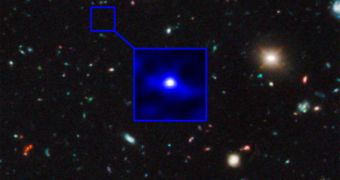Following its May 2009 general overhaul, NASA's most famous telescope has become able to peer further in space and time than ever before. This is why it recently managed to observe the oldest and most distant galaxy ever found, which formed when the Universe was very young.
The earliest analysis of the images suggest that the cosmic structure lived just 500 million years after the Big Bang, or roughly 13.2 billion years away. This makes it the oldest galaxy ever known.
Scientists say that they did not expect to find such a large galaxy so early on, given that it wasn't until 1 billion years after the Big Bang that the reionization epoch ended, and galaxies and stars began developing at rapid paces, and in large numbers.
Therefore, the recently discovered object predates all other galaxies in the known Universe. It was discovered by the NASA Hubble Space Telescope, using its Wide Field Camera 3 instrument.
In the research paper accompanying the findings, which appears in the January 26 issue of the esteemed scientific journal Nature, investigators write that the new object should provide astronomers with new insight into the earliest evolution of the Universe, and of galaxies as a whole.
“In essence, the most important aspect of this is, it provides us with some sense of how fast galaxies are building up. It provides a sort of measuring stick,” says expert Rychard Bouwens, the lead author of the new paper.
He holds joint appointments at the University of California in Santa Cruz (UCSC) and Leiden University, in the Netherlands, and was also a member of the research team, Space reports.
Scientists in the expert's group discovered the distant galaxy, now called UDFj-39546284, in archival Hubble datasets. The object was demonstrated to have a redshift of 10.3.
This is a measure of how much an object's light has been pushed towards redder wavelengths by the distance it exists between it and Earth. This is known as the Doppler shift effect.
“Everything we found was completely consistent with it being a real source. It looks really good right now,” Bouwens says, in reference to the fact that the object is still a “galaxy candidate.”
This means that some astronomical observatories still need to observe it again, and determine that it actually exists. The review instruments must also determine the galaxy's redshift, and therefore the distance it lies from Earth.
If the discovery turns out to be true, then this would be the first galaxy to be discovered living in a time when the Universe was just 4 percent of its current age, astronomers conclude.

 14 DAY TRIAL //
14 DAY TRIAL //